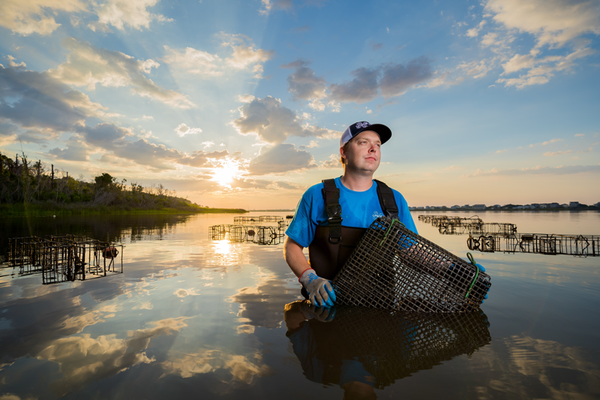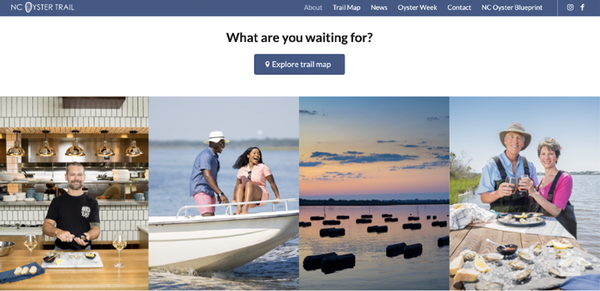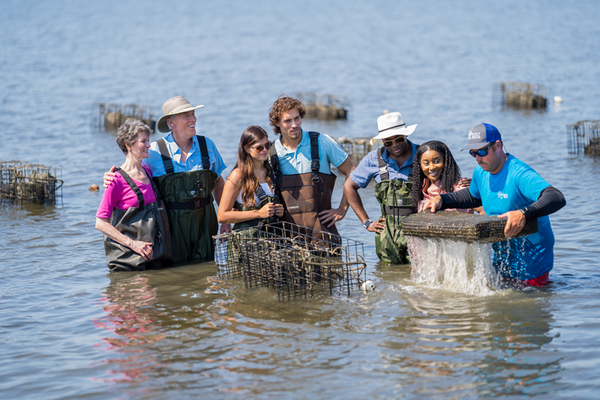Oyster Tourism
Oysters are a delicious, nutritious protein source and they provide many environmental benefits. The Eastern oyster (Crassostrea virginica) has long been wild harvested in North Carolina. Oysters, which are typically among the top five wild harvested seafoods in the state (by value), also make significant contributions to coastal heritage and local economies (NCDMF). Recently, oyster farming—also known as shellfish mariculture or marine aquaculture—has surpassed wild caught oysters in volume produced and economic impact (Edwards 2021). The shellfish mariculture industry is striving to achieve $33 million in farm-gate sales with a total economic impact of $100 million by 2030, which would support nearly 1000 coastal jobs (Shellfish Mariculture Advisory Committee 2018).
What role can North Carolina oysters play in tourism? In this article, we summarize recent research about the potential to integrate oysters into North Carolina tourism. Continuing development of markets for North Carolina oysters would support greater production and increase the environmental, social, and economic benefits oysters bring to the state.
Food tourism (traveling for the purpose of eating and learning about food) and agritourism (visiting a farm for recreation or education) encourage travelers to purchase local foods, like oysters, while visiting and when returning home (Brune et al. 2021; Stone et al. 2018). Oyster farmers such as Cody Faison (Figure 1) have been increasing demand for their products by diversifying their business with new revenue streams such as farm tours. A popular oyster tourism activity is learning about the environmental benefits of oysters and engaging in restoration efforts. Tourists can learn how oysters filter up to 50 gallons of water each day (NC Coastal Federation n.d.), provide habitat for fish and other aquatic species, and support shoreline stabilization along the North Carolina coast. Thus, oyster tourism represents a potentially valuable way to increase the demand for North Carolina oysters and safeguard their habitat.
The North Carolina Oyster Trail, which is the leading effort to curate and promote North Carolina oyster experiences, began in 2020 with support from North Carolina Sea Grant, the North Carolina Coastal Federation, and the North Carolina Shellfish Growers Association. The Trail features a broad array of shellfish (both oysters and clams) experiences that include touring oyster farms, dining at seafood restaurants, purchasing North Carolina oysters at seafood markets, and attending seafood festivals, as well as volunteering to restore coastal habitats. Visitors can find details about these experiences on the North Carolina Oyster Trail website. (Figure 2).
Who Are Potential Oyster Tourists?
To evaluate the opportunity of oyster tourism in North Carolina, we surveyed 745 potential visitors to the state’s coast in 2020. Residents of North Carolina and states that are traditional target markets for North Carolina coastal destinations (Ohio, Pennsylvania, and Virginia) were surveyed to learn about how frequently they consume oysters, the likelihood they might engage in oyster experiences such as touring an oyster farm, their overall travel preferences and behaviors, and demographics.
We grouped respondents based on their oyster consumption behaviors and preferences for oyster tourism activities. K-Means cluster analysis was used to classify respondents and a series of ANOVAs and t-tests were used to identify differences across types of oyster tourists (p < 0.05). We identified four distinct groups of oyster tourists: Source Seekers, Enthusiasts, Consumers, and Opportunists. The groups differ on what they value in a travel destination, travel activity and farm tour preferences, use of information sources ( print materials, websites, word of mouth, and social media channels), and demographics. We also identified a small group of travelers (6% of the sample)—the “Oyster Abstainers”—who do not consume oysters or have any interest in oyster experiences and were removed from this report.
All respondents were willing to accept at least $150 ticket price per personfor a two-hour oyster/clam farm tour with a maximum of six people that includes a boat ride, a guide, and educational information about oysters and clams.
Oyster Source Seekers (33% of potential coastal visitors)
Eat oysters occasionally and are interested in experiences that bring them close to the harvesting or growth of oysters such as farm tours and trails.
- Seek oyster farm tours that offer shellfish tasting and on-farm purchases.
- Want to meet the shellfish growers while touring their facilities.
- Are members of the Generation Z and Generation X cohorts.
- Tend to have children who are age 6 and living at home.
- Have lower-middle household income ($30K–$59K).
Oyster Enthusiasts (30% of potential coastal visitors)
Eat oysters frequently and are interested in all types of oyster experiences (tours, trails, events, dining, and education).
- Prefer destinations with a coastal lifestyle and strong culinary reputation, along with being rich in natural resources.
- When travelling, prefer engaging in events, cultural activities, outdoor recreation, and local seafood.
- Seek oyster farm tours that offer shellfish tasting and on-farm purchases.
- Want to meet the shellfish growers while touring their facilities.
- Are likely to use both digital and print information sources.
- Are members of the millennial or Gen X cohorts.
- Tend to have kids at least 6 years old living at home.
- Are mostly upper-middle household income ($120–$149K).
Oyster Consumers (21% of potential coastal visitors)
Eat oysters a few times per year and are interested only in oyster experiences related to consumption such as eating at a restaurant or specialty dining experiences.
- Prefer destinations with a coastal lifestyle and a strong culinary reputation.
- Prefer travel activities with events, cultural activities, outdoor recreation, and local seafood.
- Are not interested in shellfish farm tours.
- Are likely to use both digital and print information sources, other than Twitter.
- Are members of the Millennial cohort.
- Do not have children living at home.
- Are mostly lower household income (< $30K).
Oyster Opportunists (10% of potential coastal visitors)
Eat oysters infrequently and are primarily interested in oyster experiences that are convenient such as eating at a restaurant or attending events.
- Prefer travel destinations with a coastal lifestyle.
- Prefer travel activities with events, cultural activities, outdoor recreation, and local seafood.
- Are not interested in shellfish farm tours.
- Are unlikely to use YouTube and Twitter as information sources.
- Are members of the Gen X cohort.
- Do not have children living at home.
- Are mostly lower-middle to middle household income ($30K–$59K).
How Do We Grow the Oyster Tourism Industry in North Carolina?
Given the most prevalent characteristics of the different types of potential oyster tourists, we suggest five key strategies for developing, growing, and marketing oyster experiences:
- Strengthen the availability of North Carolina oysters in restaurants and at festivals across coastal communities. Most potential visitors are interested in experiencing oysters through dining or events.
- Highlight the role of local oysters in the coastal lifestyle and culinary reputation of destinations in the state. These are attributes that potential visitors value in coastal destinations.
- Create oyster farm experiences where visitors can engage with the growers and purchase shellfish on site, especially when targeting Source Seekers and Enthusiasts. Demonstrate the value of these experiences by pricing them at $150 or more per person (Figure 3.)
- Integrate oyster and outdoor recreation experiences, such as kayak tours with an oyster roast, to engage Enthusiasts and Consumers. Both groups eat oysters and seek travel activities related to outdoor recreation.
- Invest in print and digital media for promoting oyster-related activities to potential visitors. Both types of information sources are used by potential visitor groups.
The growth of oyster tourism holds considerable promise for North Carolina given that 94% of potential visitors to coastal communities have some level of interest in oyster experiences. To capitalize on that potential, oyster growers, restaurateurs, destination marketers, and other stakeholders in tourism should design and promote experiences that appeal to one or more of the potential types of visitors. Tailoring oyster experiences to specific types of visitors’ preferences can increase demand for North Carolina oysters, and the economic, social, and environmental benefits oysters bring to the state.
Additional Resources
References
Brune, Sara, Whitney Knollenberg, Kathryn T. Stevenson, Carla Barbieri, and Michele Schroeder-Moreno. 2021. “The Influence of Agritourism Experiences on Consumer Behavior Toward Local Food.” Journal of Travel Research 60, no. 6: 1318–1332. ↵
Edwards, Eric. 2021. “The Economic Impact of North Carolina's Shellfish Mariculture Industry.” Raleigh: North Carolina State University, Department of Agricultural and Resource Economics. ↵
North Carolina Coastal Federation (n.d.) “Oysters.” Newport: NC Coastal Federation. ↵
North Carolina Division of Marine Fisheries. 2022. 2022 Annual Report. Morehead City: NC Division of Marine Fisheries, License and Statistics Section. ↵
Shellfish Mariculture Advisory Committee. 2018. North Carolina Strategic Plan for Shellfish Mariculture: A Vision to 2030. Chapel Hill: Shellfish Mariculture Advisory Committee. ↵
Stone, Matthew J., Steve Migacz, and Erik Wolf. 2018. “Beyond the Journey: The Lasting Impact of Culinary Tourism Activities.” Current Issues in Tourism 22, no. 2: 147–152. ↵
Acknowledgments
We greatly appreciate the time and insight shared by our reviewers of this publication: Erin Fleckenstein, North Carolina Coastal Federation, and Dr. Patrick Holladay, Troy University-Brunswick.
This project was supported in part with funding from the National Oceanic and Atmospheric Administration (NA19OAR4170337).
Publication date: July 31, 2023
AG-950
N.C. Cooperative Extension prohibits discrimination and harassment regardless of age, color, disability, family and marital status, gender identity, national origin, political beliefs, race, religion, sex (including pregnancy), sexual orientation and veteran status.



